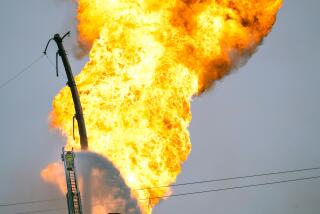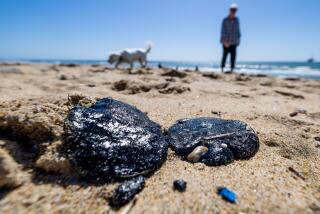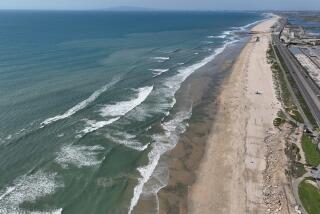Texas oil spill blocks Houston Ship Channel, threatens wildlife
Oil spilled from a barge in Galveston Bay in Texas, blocking the busy Houston Ship Channel and threatening birds at a nearby wildlife sanctuary, officials and environmentalists said.
U.S. Coast Guard officials said as much as 168,000 gallons of oil might have spilled.
Michael Lambert, spokesman for the Galveston County Office of Emergency Management, called it a âsignificant spill,â but not based on the amount of oil.
Full coverage: Gulf of Mexico Oil Spill
âThe real issue is that itâs in the ship channel, near environmentally sensitive areas. So thereâs an economic impact and an environmental impact,â he told the Los Angeles Times.
Crews were skimming oil and laying absorbent booms to contain the spread of the spill, which occurred in the channel that runs between Galveston Island and the Bolivar Peninsula, Lambert said. [Updated, 3:40 p.m. March 23: Containing the spill is likely to take days, he said.
Coast Guard Port Capt. Brian Penoyer said at a Sunday news briefing that oil had been spotted a dozen miles offshore in the Gulf of Mexico.
He said the spill blocked about about 60 vessels, including cruise ships, from using the channel.
Penoyer said all of the remaining oil had been removed from the damaged barge and the barge had been taken out of the channel. He did not say when the channel would reopen.]
The spill comes almost exactly 25 years after the massive Exxon oil spill in Valdez, Alaska, that took a devastating toll on wildlife. That spill involved 10 million gallons of oil.
The last major spill in the Gulf of Mexico was the Deepwater Horizon, or BP oil spill, which dumped 210 million gallons four years ago.
âOn the scale of the Valdez, this is not even a blip. Itâs a lot of oil, but itâs not a Valdez or a Deepwater Horizon,â Lambert said.
But Richard Gibbons, conservation director for the Houston Audubon Society, said he had already received reports and photographs of oiled birds at the Bolivar Flats Shorebird Sanctuary near the spill. Staff there reported smelling the oil on shore, but had yet to spot the oily sheen on the water.
Oiled birds that have flown into the sanctuary, Gibbons said, include ruddy turnstones, laughing gulls and American white pelicans, and some shore birds have also appeared with oil â a sign the oil has made it to shore.
The sanctuary attracts 50,000 to 70,000 shorebirds annually to its shallow mud flats. Gibbons said he was working with state officials responding to the spill to ensure the environmental effects are limited.
âWe just want to make sure the boom is going in where it needs to be,â he said.
A spokesman for emergency responders said they were investigating an unconfirmed report of an oiled bird on Eagle Point, which is not in the sanctuary.
[Updated, 3:40 p.m. March 23: Tom Harvey, a spokesman for the Texas Parks and Wildlife Department, said, âThere could be hundreds or thousands of birds of various species in the area affected by the spill.â
On Sunday, he said, a department scientist involved in spill response recovered a loon and a duck, âboth covered with sticky black oil,â from the East Beach area of Galveston facing the channel.
âOiled birds are being taken to triage trailers with hot water and basic facilities to begin cleaning the birds, staged near the spill area,â he said.
Woody Woodrow, acting wildlife branch coordinator at the spill incident command center, confirmed that four birds stained with oil were recovered and taken to a rehab center in nearby Baytown by U.S. Fish and Wildlife officials. The four included the loon and the duck recovered by Texas officials, as well as two other ducks, he said.
Woodrow said staff had also seen oiled shorebirds and pelicans still capable of flying that they had been unable to capture and treat.
Once birds are taken to the rehab center, they are washed, warmed, fed, treated for external parasites and prepared for release, he said.
Woodrow said officials were working with the Audubon Society and other groups to monitor the effect of the spill not just on local and migratory birds, but also on other at-risk wildlife in the area, including dolphins and sea turtles.]
The spill was reported at 12:30 p.m. Saturday by the captain of a 585-foot Liberian-flagged ship, Summer Wind, which collided with the barge, Coast Guard officials said.
The cause of the crash was still under investigation Sunday, according to Coast Guard Lt. Sam Danus. Two crew members aboard the tug and barge were hospitalized as a precaution because of exposure to hydrogen sulfide, Danus said.
The barge was carrying nearly a million gallons of marine fuel oil and was being towed by the Miss Susan tugboat, Danus told The Times. He said only one of the bargeâs tanks was breached, and although it contained about 168,000 gallons of oil, it was not clear how much oil had spilled. Crews were working Sunday to remove the remaining oil from the barge, he said.
Greg Beuerman, a representative of Kirby Inland Marine, which owns the tugboat and barge, told The Times that the spill may turn out to have been less than feared once officials finish their cleanup.
[Updated, 5:22 p.m. March 23: Gov. Rick Perry said in a statement that Texas would âensure the spill is contained and cleaned up with as little impact as possible to the environment and commerce.â
âWe are thankful to the responders and personnel who are working diligently to respond to this situation,â he said.]
[For the record, 5:22 p.m. March 23: An earlier version of this post said the spill occurred on the eve of the 25th anniversary of the Exxon Valdez spill. Actually, it occurred two days before. March 24 is the 25th anniversary of the Exxon Valdez spill.]
More to Read
Sign up for Essential California
The most important California stories and recommendations in your inbox every morning.
You may occasionally receive promotional content from the Los Angeles Times.











